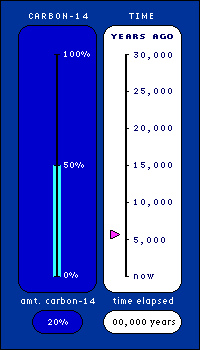
|

|
(My So-Called) Half-Life Back to The Dating Game Here's an example of how half-life works: Let's say you have 80 ants, and these ants have a half-life of ten days. In ten days, then, 40 of your ants would still be alive. Ten days after that, 20 ants would still be alive. Ten more days, and ten would be alive. You get the picture. If you took just one of these ants, though, there would be no way to predict when it would die. It might die right away or it might live for a long time. It's only when you have a lot of them that this half-life thing works. In real life, you can't use the half-life method to determine ant death rates. You can, however, use the method to determine when radioactive atoms will decay into some other form.
Next: Detection Section (what's your deflection?) Does Race Exist? | Meet Kennewick Man Claims for the Remains | The Dating Game | Resources Transcript | Site Map | Mystery of the First Americans Home Editor's Picks | Previous Sites | Join Us/E-mail | TV/Web Schedule About NOVA | Teachers | Site Map | Shop | Jobs | Search | To print PBS Online | NOVA Online | WGBH © | Updated November 2000 |
